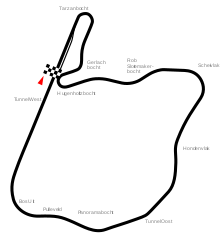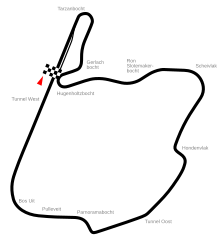
The Canadian Grand Prix is an annual motor racing event held since 1961. It has been part of the Formula One World Championship since 1967. It was first staged at Mosport Park in Bowmanville, Ontario, as a sports car event, before alternating between Mosport and Circuit Mont-Tremblant, Quebec, after Formula One took over the event. After 1971, safety concerns led to the Grand Prix moving permanently to Mosport. In 1978, after similar safety concerns with Mosport, the Canadian Grand Prix moved to its current home at Circuit Gilles Villeneuve on Notre Dame Island in Montreal, Quebec.

The British Grand Prix is a Grand Prix motor race organised in the United Kingdom by the Royal Automobile Club. First held in 1926, the British Grand Prix has been held annually since 1948 and has been a round of the FIA Formula One World Championship every year since 1950. In 1952, following the transfer of the lease of the Silverstone Circuit to the British Racing Drivers' Club, the RAC delegated the organisation of the race to the BRDC for the first time, and this arrangement has continued for all British Grands Prix held at Silverstone since then.

The German Grand Prix was a motor race that took place most years since 1926, with 75 races having been held. The race has been held at only three venues throughout its history: the Nürburgring in Rhineland-Palatinate, Hockenheimring in Baden-Württemberg and occasionally AVUS in Berlin. The race continued to be known as the German Grand Prix, even through the era when the race was held in West Germany.

The Belgian Grand Prix is a motor racing event which forms part of the Formula One World Championship. The first national race of Belgium was held in 1925 at the Spa region's race course, an area of the country that had been associated with motor sport since the very early years of racing. To accommodate Grand Prix motor racing, the Circuit de Spa-Francorchamps race course was built in 1921 but until 1924 it was used only for motorcycle racing. After the 1923 success of the new 24 hours of Le Mans in France, the Spa 24 Hours, a similar 24-hour endurance race, was run at the Spa track.

The Portuguese Grand Prix is a motorsports event that was first held in 1951 as a sportscar event, and then intermittently disappearing for many years before being revived again. In 1964 event was held as a sportscar race, and the 1965 and 1966 editions being held for Formula Three entrants. The event was part of the Formula One World Championship in 1958–1960, then again between 1984 and 1996, and after a long hiatus, it was revived for 2020 and 2021. The event has been held at several circuits throughout its history.

The San Marino Grand Prix was a Formula One championship race which was run at the Autodromo Internazionale Enzo e Dino Ferrari in the town of Imola, near the Apennine mountains in Italy, between 1981 and 2006. It was named after nearby San Marino as there already was an Italian Grand Prix held at Monza even though the Imola Circuit was in Italy and not within San Marino's own territory. In 1980, when Monza was under refurbishment, the Imola track was used for the 51st Italian Grand Prix.

The Italian Grand Prix is the fifth oldest national motor racing Grand Prix, having been held since 1921. Since 2013, it has been the Grand Prix held the most times, with 93 editions as of 2023. It is one of the two Grands Prix which has run as an event of the Formula One World Championship Grands Prix every season, continuously since the championship was introduced in 1950. Every Formula One Italian Grand Prix in the World Championship era has been held at Monza except in 1980, when it was held at Imola.

The Spanish Grand Prix is a Formula One motor racing event currently held at the Circuit de Barcelona-Catalunya. The race is one of the oldest in the world still contested, celebrating its centenary in 2013. The race had modest beginnings as a production car race. Interrupted by the First World War, the race waited a decade for its second running before becoming a staple of the European calendar. In 1927 it was part of the World Manufacturers' Championship; it was promoted to the European Championship in 1935 before the Spanish Civil War brought an end to racing. The race was successfully revived in 1967 and has been a regular part of the Formula One World Championship since 1968 at a variety of venues.

The Austrian Grand Prix is a Fédération Internationale de l'Automobile sanctioned motor racing event that was held in 1964, 1970–1987, 1997–2003, and then returned to the Formula One calendar in 2014.

The South African Grand Prix was first run as a Grand Prix motor racing handicap race in 1934 at the Prince George Circuit at East London, Cape Province. It drew top drivers from Europe including Bernd Rosemeyer, Richard "Dick" Seaman, Richard Ormonde Shuttleworth and the 1939 winner Luigi Villoresi.
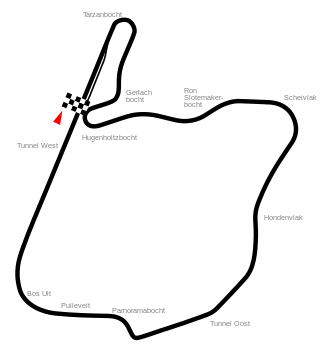
The 1973 Dutch Grand Prix was a Formula One motor race held at Zandvoort on July 29, 1973. It was race 10 of 15 in both the 1973 World Championship of Drivers and the 1973 International Cup for Formula One Manufacturers. Zandvoort returned to the Formula One calendar following a year's absence for extensive safety upgrades to the race track including new asphalt, new barriers and a new race control tower. Jackie Stewart won the race, this Grand Prix being fourth of five wins for Stewart during the 1973 Formula One season, and he became the most successful Formula One driver of all time with his 26th Grand Prix victory, surpassing Jim Clark's record of 25 victories. Stewart's friend and future world champion James Hunt scored his first podium finish.

The 1985 Dutch Grand Prix was a Formula One motor race held at Circuit Zandvoort on 25 August 1985. It was the eleventh round of the 1985 FIA Formula One World Championship and the 34th World Championship Grand Prix to be held in the Netherlands. The race was held over 70 laps of the four kilometre circuit for a race distance of 298 kilometres. The race also proved to be the 25th and last Grand Prix victory for triple World Champion Niki Lauda, driving a McLaren-TAG. Lauda's teammate Alain Prost was second, with Brazilian racer Ayrton Senna third in his Lotus-Renault. However, it was also to be the last Dutch Grand Prix for 36 years. It was planned to be re-introduced in 2020, on a revised Zandvoort circuit, however the re-introduction was postponed due to the COVID-19 pandemic, which would be eventually cancelled. The first race back at Zandvoort eventually turned out to be in 2021, won by Max Verstappen, the nation's first World Champion. As of 2023, all three races since the track's return have been won by Verstappen.
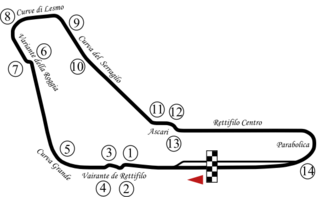
The 1986 Italian Grand Prix was a Formula One motor race held at Monza on 7 September 1986. It was the thirteenth race of the 1986 Formula One World Championship.

The 1990 Australian Grand Prix was a Formula One motor race held at Adelaide on 4 November 1990. It was the sixteenth and final race of the 1990 Formula One World Championship, and the 500th race to contribute to the World Drivers' Championship since the series started in 1950. The race was the 55th Australian Grand Prix, and the sixth to be part of the Formula One World Championship. It was held over 81 laps of the 3.78-kilometre (2.35 mi) circuit for a race distance of 306 kilometres (190 mi).

The 1985 FIA Formula One World Championship was the 39th season of FIA Formula One motor racing. It featured the 1985 Formula One World Championship for Drivers and the 1985 Formula One World Championship for Manufacturers, both of which commenced on 7 April and ended on 3 November after sixteen races.

The 1984 FIA Formula One World Championship was the 38th season of Fédération Internationale de l'Automobile (FIA) Formula One motor racing. It featured the 1984 Formula One World Championship for Drivers and the 1984 Formula One World Championship for Manufacturers, both of which commenced on 25 March and ended on 21 October after sixteen races.
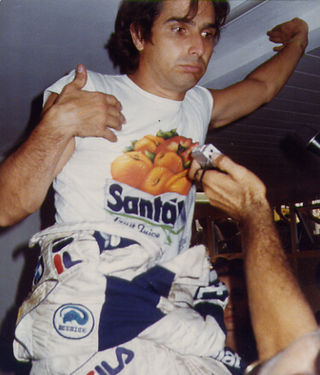
The 1983 FIA Formula One World Championship was the 37th season of FIA Formula One motor racing. It featured the 1983 Formula One World Championship for Drivers and the 1983 Formula One World Championship for Manufacturers, which were contested concurrently over a fifteen-race series that commenced on 13 March and ended on 15 October.

Roger Williamson was a British racing driver and a two time British Formula 3 champion, who died during his second Formula One race, the 1973 Dutch Grand Prix at Zandvoort Circuit in the Netherlands.
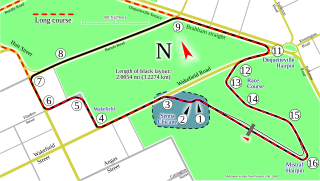
The Adelaide Street Circuit is a temporary street circuit in the East Parklands adjacent to the Adelaide central business district in South Australia, Australia.

The McLaren MP4/2 was a Formula One car produced by McLaren for the 1984 season. An iteration of it, the MP4/2B, was used in the 1985 season, and a slightly updated version, the MP4/2C, raced in the 1986 season for McLaren. It was closely based on the MP4/1E model that was used as a test car, used in the final races of 1983.

